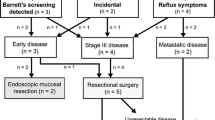Abstract
Background Endoscopic surveillance of patients with Barrett’s oesophagus is recommended to detect early carcinoma. The practice patterns of endoscopists since the publication of more recent management guidelines remain unknown.
Methods All endoscopists (n=68) in the Irish Medical Directory and their trainees were sent a postal questionnaire on Barrett’s surveillance.
Results Fifty-five per cent (30/54) perform surveillance on all patients with Barrett’s oesophagus and 38% on selected patients. In patients with no dysplasia, repeat endoscopy was more commonly practiced annually (28/54) than every two to three years (23/54). Surgeons were more likely to perform surveillance annually than gastroenterologists (75% vs 40%). Only 26% of endoscopists took four-quadrant biopsies every 2cm. Intervention was recommended by a majority (28/54) of endoscopists in a patient with high grade dysplasia. A majority of respondents (47/54) would have surveillance if they were found to have Barrett’s oesophagus.
Conclusion Most endoscopists in Ireland do not adhere to recent guidelines in their management of Barrett’s oesophagus. Surgical endoscopists perform surveillance more frequently than their medical colleagues.
Similar content being viewed by others
References
Sampliner R. Practice guidelines on the diagnosis, surveillance and therapy of Barrett’s esophagus. The Practice Parameters Committee of the American College of Gastroenterology.Am J Gastroenterol 1998; 93: 1028–32.
Anon. The role of endoscopy in the surveillance of premalignant conditions of the upper gastrointestinal tract. Guidelines for clinical application.Gastrointest Endosc 1988 May-Jun; 34 (3 Suppl): 18S–20S.
Dent J, Brennan CG, Collen MG et al. Barrett’s oesophagus. Working Party Report of the World Congress of Gastroenterology. Melbourne. Blackwell Scientific Publications 1990: pp17–26.
Van Sandick JW, van Lanschot JJB, Kuiken BW et al. Impact of endoscopic surveillance of Barrett ’s oesophagus on pathological stage and clinical outcome of Barrett’s carcinoma.Gut 1998; 43: 216–22.
Wright TA, Gray MR, Morris AI et al. Cost effectiveness of detecting Barrett’s cancer.Gut 1996; 39: 574–9.
Van der Veen AH, Dees J, Blankenstein JD, van Blankenstein M. Adenocarcinoma in Barrett’s oesophagus: an overrated risk.Gut 1989; 30 (1): 14–8.
MacDonald CE, Wicks AC, Playford RJ. Final results from 10 year cohort of patients undergoing surveillance for Barrett’s oesophagus: observational study.BMJ 2000; 321: 1252–5.
Bani-Hani K, Sue-Ling H, Johnston D, Axon AT, Martin IG. Barrett’s oesophagus: results from a 13 year surveillance programme.Eur J Gastroenterol Hepatol 2000; 12 (6): 649–54.
Levine DS. Management of dysplasia in the columnar-lined esophagus.Gastroenterol Clin North Am 1997; 26 (3): 613–34.
Smith AM, Maxwell-Armstrong CA, Welch NT, Scholfield JH. Surveillance for Barrett’s oesophagus in the UK.Br J Surg 1999; 86 (2): 276–80.
Falk GW, Ours TM, Richter JE. Practice patterns for surveillance of Barrett’s oesophagus in the United States.Gastrointest Endosc 2000; 52 (2): 197–203.
Ackroyd R, Wakefield SE, Williams JL, Stoddard CJ, Reed MW. Surveillance of Barrett’s oesophagus: a need for guidelines?Dis Esophagus 1997; 10 (3): 185–9.
Eloubeidi MA, Provenzale D. Does this patient have Barrett’s esophagus? The utility of predicting Barrett’s esophagus at the index endoscopy.Am J Gastroenterol. 1999; 94 (4): 937–43.
Woolf GM, Riddell RH, Irvine EJ, Hunt RH. A study to examine agreement between endoscopy and histology for the diagnosis of columnar lined (Barrett’s) esophagus.Gastrointest Endosc 1989; 35 (6): 541–4.
Schnell TG, Sontag SJ, Chejfec G et al. Long-term nonsurgical management of Barrett’s esophagus with high-grade dysplasia.Gastroenterology 2001; 120: 1607–19.
Weston AP, Sharma P, Topalovski M et al. Long-term follow-up of Barrett’s high-grade dysplasia.Am J Gastroenterol 2000; 95 (8): 1888- 93.
Author information
Authors and Affiliations
Corresponding author
Rights and permissions
About this article
Cite this article
Moss, A., Clarke, E., Crowe, J. et al. Management of Barrett’s oesophagus in 2001 in Ireland. Ir J Med Sci 172, 174–176 (2003). https://doi.org/10.1007/BF02915284
Issue Date:
DOI: https://doi.org/10.1007/BF02915284




